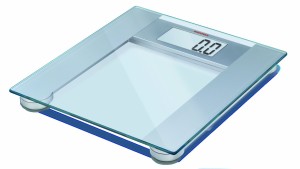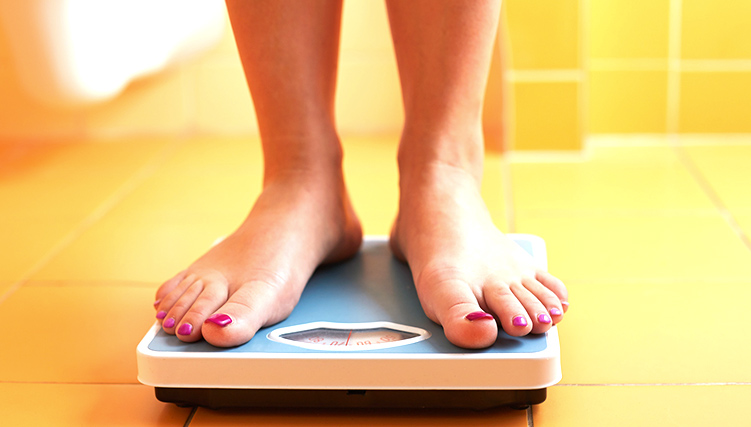Sometimes it seems that diets are all about weight, when weight isn’t really what we’re concerned about.
Would we be bothered to weigh double our ideal weight if it were all somehow tucked away so that it had no effect on health or appearance? Probably not. Fitness gyms and bariatric surgery centers would go out of business and cars would ride a little lower.
Unfortunately, in the real world, the extra weight isn’t tucked away. It changes appearance and has a detrimental effect on health. We want to measure fat, not weight, but there’s no easy way to measure just fat. Tape measures work, but they can be awkward, and it may be difficult to measure in exactly the same place unless you trace your circumference with a Sharpie. It can also be difficult to know when you’ve got your belly sucked in as much as you did the last time you measured. We use weight instead, but there’s a problem: your weight includes a lot of things besides fat. It includes several gallons of water plus bones and muscle along with what you ate yesterday and maybe the day before. If you ate a lot of salty or sugary foods, your weight may be up by a pound or two (0.5-1kg) from retained water. If you drank a lot of alcohol, its dehydrating effect may cause you to lose the same amount of water, which your body will replace as soon as the alcohol effect wears off, causing another big shift in your weight.
Even though many scales imply super precision with a digit after the decimal place (such as saying 150.1 pounds or 68.2 kg) it’s really not that precise a measurement of fat because so much changes in your water-rich body besides fat. A few hours from now—after you use the bathroom or drink a beer or have a meal, your weight may be different on the scale even though your body fat hasn’t changed. When it comes to measuring your fat content, it may be helpful to just ignore that extra digit.
 Precision is important in a scale, and a scale can have good precision even if it has no digits after the decimal place. You want a scale that’s going to say the same thing every time you put an identical weight on it. If you step on a scale, read it, then step off and back on for another reading, a precise scale will read the same weight or vary at most by 0.1. I’ve found that Soehnle
Precision is important in a scale, and a scale can have good precision even if it has no digits after the decimal place. You want a scale that’s going to say the same thing every time you put an identical weight on it. If you step on a scale, read it, then step off and back on for another reading, a precise scale will read the same weight or vary at most by 0.1. I’ve found that Soehnle scales offer good precision at a decent price. Scales that offer body fat measurements offer no real added value because electronic body fat measurement techniques yield highly variable results, making the devices more gimmick than tool.
Now that you’ve determined whether your scale has adequate precision, it’s time to weigh.
Weighing yourself may not seem like a challenge. Step on the scale, read, step off. What can go wrong? More than you might think. Here are some suggestions for getting reliable numbers without needlessly frustrating yourself, going bonkers or wasting your time chasing meaningless numbers. Misinterpreting your weight change could lead you to make a wrong decision about whether your effort to lose or maintain weight is working.
- Use the same scale for all your measurements. Comparing weights from two scales, even if one is at a doctor’s office, is asking for confusion.
- For consistency, weigh yourself at the same time of day, preferably in the morning after urinating. Since the water content of your body can cause your weight to fluctuate, weighing after you’ve been sleeping and have emptied your bladder gives your body a chance to get rid of the excess.
- Be realistic about how much fat you can burn in a day. A pound of fat on your body can provide about 3,500 calories worth of fuel for your body–it’s the same as eating four sticks of butter. Most people burn 2,000-2,500 calories per day and replace that with what they eat. If you don’t eat quite enough to replace the loss, say 500 fewer calories than you burn, that means your net loss of fat is only 0.14 pounds (0.065 kg). With changes in water and bowel content, that small weight change may be undetectable even with a very good scale. Over a week’s time, the daily loss adds up to a pound (0.45 kg) per week, but with water fluctuations of 1-2 pounds (0.5-1 kg) or more, even that loss may be completely hidden by shifts in water weight. Consistent measurements over the course of several weeks will show what’s really going on with your body.
- Expecting to see weight loss following your sweaty hour on the treadmill? Don’t. Even if you run fast and manage 15 km (9.4 miles) in the hour, the workout will only burn about a third of a pound of fat. Your sweat loss probably amounts to more, but the sweating will make you thirsty, so maybe you drink a liter to replace the loss and now you’ve got 2.2 pounds (1 kg) of water shifting around your body. If you eat following the exercise and before weighing, then your body has the opportunity to replace the used fuel, so even a marathoner may see no measureable weight loss the morning after. Exercise offers lots of good things for your body, and I strongly encourage you to do as much as you can, but don’t stop exercising just because you don’t see immediate weight loss on your scale.
- Compare your weight week-to-week (comparing today’s weight to the same day of the week of last week) not day-to-day. Your body can change its water content quickly. The amount of salt you eat, the amount of sweets you eat, what’s in your intestines and, in women, menstrual cycles, can all cause significant changes in weight. Use a calendar, a spreadsheet, or an app with moving averages.
- Even if your scale passes the precision test, disregard any change that’s less than a pound (0.5 kg). That means if your weight goes up less than a pound, don’t fret, and if it goes down by less than a pound, don’t get too excited. It’s okay to record it, but small changes are not significant indicators of your progress. Fluctuations in the amount of water in your body can account for that sort of change, and you can drive yourself crazy tracking little variations and trying to account for them. When you see a trend developing, such as down a pound two weeks in a row, you can tell you’re headed in the right direction.
- Don’t let your scale be your only measuring tool. Notice the fit of your clothes and which notch on your belt you’re using. The tightness of your clothing can indicate fat loss just as well, if not better than a scale. If your shorts fall off, you’re doing well. If your waistband or belt is getting tighter over the course of 2-3 weeks, it’s probably time to change course.
Two Weighing Hints Just for Fast-5ers:
- Weight loss immediately after starting Fast-5 is likely to be water weight. With fewer meals, you have a lower insulin level for most of the day. Insulin signals your kidneys to retain water, so the lack of it causes your kidneys to let go of water, sometimes dropping several pounds in a week or two. It’s real weight and it has to go sometime—just don’t expect to maintain that pace. Not everyone loses a lot of water weight early on, so if you don’t see that early loss, it doesn’t mean something is wrong. A pound per week of fat loss is typical starting after the three-week adjustment period. The reduced water retention may explain the drop in blood pressure that Fast-5ers often report.
- Fast-5ers often see inches (centimeters) go before pounds, so don’t worry if your clothes feel looser but your weight hasn’t changed. That’s typical, and it’s a clear indicator that you’re mobilizing fat. To fuel your body’s energy needs, fat may be redistributed from bulky depots like hips and belly to spread out through the body where it’s going to be used as fuel.

